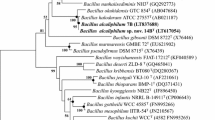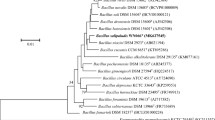Abstract
Two novel (18CT and 6C) Gram-stain-positive, rod shaped, motile and endospore-forming bacterial strains were isolated from Lonar soda lake, India. Based on 16S rRNA gene sequence analysis, strains 18CT and 6C were identified as belonging to the class Firmibacteria, and were most closely related to Bacillus cohnii KCTC 3572T (99.3 and 99.9%, respectively), Bacillus zhanjiangensis KCTC 13713T (97.4 and 98.0%, respectively), Bacillus halmapalus LMG 17950T (97.0 and 97.6%, respectively) and other members in the genus Bacillus (<97.0%). However, the DNA–DNA relatedness between 18CT and 6C and B. cohnii KCTC 3572T (49.6 ± 0.9 and 51.6 ± 0.7, respectively), B. zhanjiangensis KCTC 13713T (42.9 ± 0.8 and 47.1 ± 0.3, respectively) and B. halmapalus LMG 17950T (39.9 ± 0.8 and 40.8 ± 0.3, respectively) indicated that the novel strains were distantly related to these strains. Further, the high 16S rRNA gene sequence similarity (100%) and DNA–DNA relatedness (90 ± 5%) suggested that strains 18CT and 6C were members of a genomospecies. The strains grew optimally at a pH of 7.5 with 2–3% (w/v) NaCl and temperature of 37 °C. Strains 18CT and 6C were catalase and oxidase negative. The cell wall of strain 18CT contained meso-diaminopimelic acid as the diagnostic diamino acid, which was in contrast with its nearest neighbour B. cohnii KCTC 3572T, which contained ornithine and aspartic acid. Polar lipids include diphosphatidylglycerol (DPG), phosphatidylglycerol (PG), phosphatidylethanolamine (PE), an unknown phospholipid (PL) and three unknown lipids (L1-3). The predominant isoprenoid quinone was MK-7. iso-C15:0 (32.5%) was the predominant fatty acid and significant proportions of anteiso-C15:0 (19.5%), C16:0 (11.5%), iso-C17:0 (9.5%) and anteiso-C17:0 (6.3%) were also detected. The DNA G + C content of strains 18CT and 6C were 39.3 and 39.2 mol%, respectively. The results of molecular, biochemical and chemotaxonomic tests showed a clear differentiation of strains 18CT and 6C from all other members of the genus Bacillus, for which the name Bacillus catenulatus sp. nov. is proposed. The type strain is 18CT (=KCTC 33781T = CGMCC 1.15475T).

Similar content being viewed by others
References
Balcàzar JL, Rojas-Luna T (2007) Inhibitory activity of probiotic Bacillus subtilis UTM 126 against Vibrio species confers protection against vibriosis in juvenile shrimp (Litopenaeus vannamei). Curr Microbiol 55:409–412
Banat IM, Makkar RS, Cameotra S (2000) Potential commercial applications of microbial surfactants. Appl Microbiol Biotechnol 53:495–508
Chen YG, Hu SP, Tang SK, He JW, Xiao JQ, Zhu HY, Li WJ (2011) Bacillus zhanjiangensis sp. nov., isolated from an oyster in South China Sea. Antonie Van Leeuwenhoek 99:473–480
Claus D, Berkeley CW (1986) The genus Bacillus. In: Sneath PHA (ed) Bergey’s manual of systematic bacteriology, vol 2. Williams and Wilkins, Baltimore, pp 1105–1139
Collins M, Jones D (1980) Lipids in the classification and identification of coryneform bacteria containing peptidoglycans based on 2, 4-diaminobutyric acid. J Appl Microbiol 48:459–470
Feng L, Liu D, Sun X, Wang G, Li M (2016) Bacillus cavernae sp. nov. isolated from cave soil. Int J Syst Evol Microbiol 66:801–806
Hasegawa T, Takizaea M, Tanida S (1983) A rapid analysis for chemical grouping of aerobic actinomycetes. J Gen Appl Microbiol 29(4):319–322
Holt JG, Kreig NR, Sneath PHA, Stanley JT, Williams ST (1994) Bergey’s manual of determinative bacteriology. Williams and Wilkins, Baltimore
Kämpfer P, Rosselló-Mora R, Falsen E, Busse HJ, Tindall BJ (2006) Cohnella thermotolerans gen. nov., sp. nov., and classification of ‘Paenibacillus hongkongensis’ as Cohnella hongkongensis sp. nov. Int J Syst Evol Microbiol 56:781–786
Kates M (1972) Techniques of lipidology. Elsevier, New York
Kates M (1986) Techniques of lipidology: isolation, analysis, and identification of lipids. Elsevier, Amsterdam
Kimura M (1980) A simple method for estimating evolutionary rate of base substitutions through comparative studies of nucleotide sequences. J Mol Evol 16:111–120
Kodaka H, Armfield AY, Lombard GL, Dowell VR (1982) Practical procedure for demonstrating bacterial flagella. J Clin Microbiol 16:948–952
Lim JM, Jeon CO, Lee JR, Park DJ, Kim CJ (2007) Bacillus kribbensis sp. nov., isolated from a soil sample in Jeju. Korea Int J Syst Evol Microbiol 57:2912–2916
Logan NA, Berge O, Bishop AH, Busse H-J, De Vos P, Fritze D et al (2009) Proposed minimal standards for describing new taxa of aerobic, endospore forming bacteria. Int J Syst Evol Microbiol 59:2114–2121
Marmur J (1961) A procedure for the isolation of deoxyribonucleic acid from microorganisms. J Mol Biol 3:208–218
Meier-Kolthoff Jan P, Alexander FA, Klenk HP, Göker M (2013) Genome sequence-based species delimitation with confidence intervals and improved distance functions. BMC Bioinform 14:60
Mesbah M, Premachandran U, Whitman WB (1989) Precise measurement of the G+C content of deoxyribonucleic acid by high-performance liquid chromatography. Int J Syst Bacteriol 39:159–167
Nielsen P, Fritze D, Priest FG (1995) Phenetic diversity of alkaliphilic Bacillus strains: proposal for nine new species. Microbiology 141:1745–1761
Oren A, Duker S, Ritter S (1996) The polar lipid composition of Walsby’s square bacterium. FEMS Microbiol Lett 138:135–140
Oren A, Ventosa A, Grant WD (1997) Proposed minimal standards for description of new taxa in the order Halobacteriales. Int J Syst Bacteriol 47:233–238
Rheims H, Frühling A, Schumann P, Rohde M, Stackebrandt E (1999) Bacillus silvestris sp. nov., a new member of the genus Bacillus that contains lysine in its cell wall. Int J Syst Bacteriol 49:795–802
Sasser M (1990) Identification of bacteria by gas chromatography of cellular fatty acids. MIDI Inc, Newark
Schleifer KH (1985) Analysis of the chemical composition and primary structure of murein. Methods Microbiol 18:123–156
Schleifer KH, Kandler O (1972) Peptidoglycan types of bacterial cell walls and their taxonomic implications. Bacteriol Rev 36:407–477
Schumann P (2011) Peptidoglycan structure. In: Rainey F, Oren A (eds) Taxonomy of prokaryotes, methods in microbiology, vol 38. Academic Press, London, pp 101–129
Smibert RM, Krieg NR (1981) General characterization. In: Gerhardt P, Murray RGE, Costilow RN, Nester EW, Wood WA, Krieg NR, Phillips GB (eds) Manual of methods for general microbiology. American Society for Microbiology, Washington, DC, pp 409–443
Sonalkar VV, Mawlankar R, Venkata Ramana V, Joseph N, Shouche YS, Dastager SG (2015) Bacillus filamentosus sp. nov., isolated from sediment sample. Antonie Van Leeuwenhoek 107:433–441
Sorokulova IB, Pinchuk IV, DenayrollesM Osipova IG, Huang JM, Cutting SM, Urdaci MC (2008) The safety of two Bacillus probiotic strains for human use. Dig Dis Sci 53:954–963
Spanka R, Fritze D (1993) Bacillus cohnii sp. nov., a new, obligately alkaliphilic, oval-spore-forming Bacillus species with ornithine and aspartic acid instead of diaminopimelic acid in the cell wall. Int J Syst Bacteriol 43:150–156
Stackebrandt E, Ebers J (2006) Taxonomic parameters revisited: tarnished gold standards. Microbiol Today 33:152–155
Stackebrandt E, Goebel BM (1994) Taxonomic note: a place for DNA–DNA reassociation and 16S rRNA sequence analysis in the present species definition in bacteriology. Int J Syst Bacteriol 44:846–849
Tamaoka J, Fujimura Y-K, Kuraishi H (1983) Analysis of bacterial menaquinone mixtures by high performance liquid chromatography. J Appl Microbiol 54:31–36
Tamura K, Peterson D, Peterson N, Stecher G, Nei M, Kumar S (2011) MEGA5: molecular evolutionary genetics analysis (MEGA) using maximum likelihood, evolutionary distance and maximum parsimony methods. Mol Biol Evol 28:2731–2739
Tindall BJ (1990a) Lipid composition of Halobacterium lacusprofundi. FEMS Microbiol Lett 66:199–202
Tindall BJ (1990b) A comparative study of the lipid composition of Halobacterium saccharovorum from various sources. Syst Appl Microbiol 13:128–130
Tourova TP, Antonov AS (1987) Identification of microorganisms by rapid DNA–DNA hybridization. Methods Microbiol 19:333–355
Vishnuvardhan Reddy S, Aspana S, Tushar DL, Sasikala CH, Ramana V (2013) Spirochaeta sphaeroplastigenens sp. nov., a halo-alkaliphilic, obligately anaerobic spirochaete isolated from soda lake Lonar. Int J Syst Evol Microbiol 63:2223–2228
Yoon SH, Ha SM, Kwon S, Lim J, Kim Y, Seo H, Chun J (2016) Introducing EzBioCloud: a taxonomically united database of 16S rRNA and whole genome assemblies. Int J Syst Evol Microbiol. doi:10.1099/ijsem.0.001755
You ZQ, Li J, Qin S, Tian XP, Wang FZ, Zhang S, Li WJ (2013) Bacillus abyssalis sp. nov., isolated from a sediment of the South China Sea. Antonie Van Leeuwenhoek 103(5):963–969
Yumoto I, Hirota K, Yamaga S, Nodasaka Y, Kawasaki T, Matsuyama H, Nakajima K (2004) Bacillus asahii sp. nov., a novel bacterium isolated from soil with the ability to deodorize the bad smell generated from short-chain fatty acids. Int J Syst Evol Microbiol 54:1997–2001
Zhang YZ, Chen WF, Li M, Sui XH, Liu H-C, Zhang XX, Chen WX (2012) Bacillus endoradicis sp. nov., an endophytic bacterium isolated from soybean root. Int J Syst Evol Microbiol 62:359–363
Acknowledgements
SVR and MT thank Department of Science and Technology, Government of India, for providing FTSYS project Grants (SB/FT/LS-115/2012 and SB/FT/LS-320/2012, respectively).
Author information
Authors and Affiliations
Corresponding author
Additional information
Communicated by Erko Stackebrandt.
The EMBL accession number for the 16S rRNA gene sequences of strains 18CT and 6C are LT617055 and LT837689, respectively. The DPD Taxonumber of the type strain 18CT is TA00143.
Electronic supplementary material
Below is the link to the electronic supplementary material.
203_2017_1413_MOESM1_ESM.pptx
Supplementary Fig. 1. Phase contrast photograph of strain 18CT; A, growth at pH 7.5; B, growth at pH 9.5. Bar, 0.5 μm. Supplementary Fig. 2. Two-dimensional thin-layer chromatogram of polar lipid extracts of strain 18CT and phylogenetically related Bacillus species. The first direction was developed in CHCl3:CH3OH:H2O (75: 32: 4 v/v) and the second in CHCl3: CH3OH: CH3COOH: H2O (86: 16: 15: 4 v/v). PG, phosphatidylglycerol; DPG, diphosphatidylglycerol; PE, phosphatidylethanolamine; PL, phospholipid; L1-8, Unknown lipids. Supplementary Fig. 3. Thin-layer chromatogram of cell wall extracts of 18CT and phylogenetically related Bacillus species. This was developed in methanol: pyridine: water: 12 N HCl (32: 4: 7: 1 v/v) (PPTX 838 kb)
Rights and permissions
About this article
Cite this article
Sultanpuram, V.R., Mothe, T., Chintalapati, S. et al. Bacillus catenulatus sp. nov., an alkalitolerant bacterium isolated from a soda lake. Arch Microbiol 199, 1391–1397 (2017). https://doi.org/10.1007/s00203-017-1413-y
Received:
Revised:
Accepted:
Published:
Issue Date:
DOI: https://doi.org/10.1007/s00203-017-1413-y




